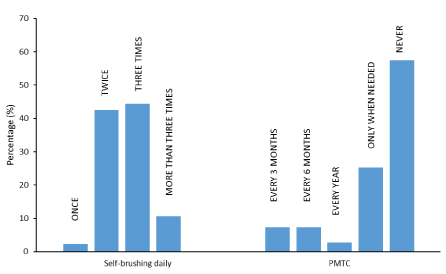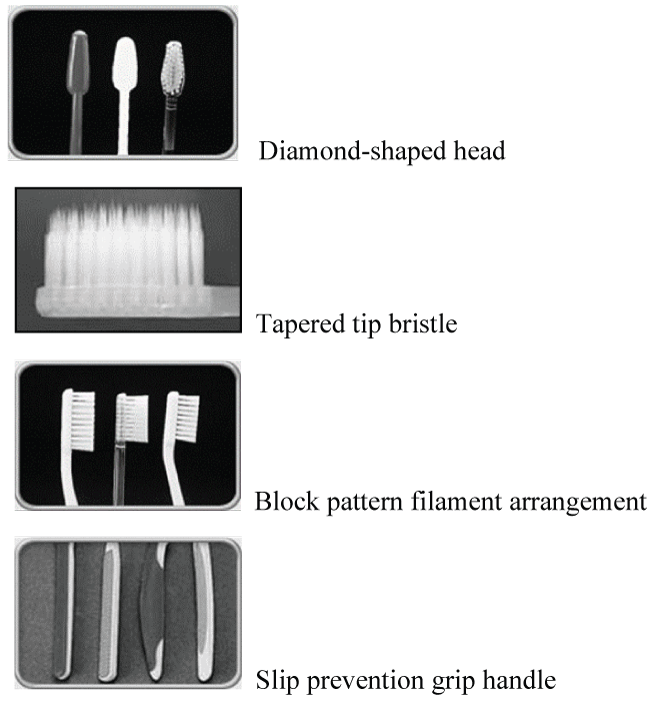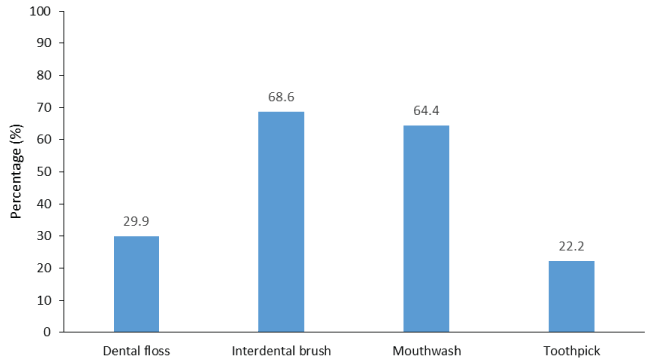International Journal of Oral and Dental Health
Oral Hygiene Practices among Fixed Orthodontic Patients in a University Dental Setting
Jin Han Lee, Asma Alhusna Abang Abdullah* and Nurul Asyikin Yahya
Faculty of Dentistry, University Kebangsaan Malaysia, Kuala Lumpur, Malaysia
*Corresponding author:
Asma Alhusna Abang Abdullah, Department of Orthodontics, Faculty of Dentistry, University Kebangsaan Malaysia, Kuala Lumpur, Malaysia, E-mail: asmaabdullah@ukm.edu.my
Int J Oral Dent Health, IJODH-2-027, (Volume 2, Issue 2), Research Article; ISSN: 2469-5734
Received: February 15, 2016 | Accepted: April 09, 2016 | Published: April 12, 2016
Citation: Lee JH, Abdullah AAA, Yahya NA (2016) Oral Hygiene Practices among Fixed Orthodontic Patients in a University Dental Setting. Int J Oral Dent Health 2:027. 10.23937/2469-5734/1510027
Copyright: © 2016 Lee JH, et al. This is an open-access article distributed under the terms of the Creative Commons Attribution License, which permits unrestricted use, distribution, and reproduction in any medium, provided the original author and source are credited.
Abstract
Objectives: To identify self-reported oral hygiene practices among fixed orthodontic patients.
Methods: A self-administered questionnaire was answered by 261 fixed orthodontic patients. The questionnaire addressed two aspects: socio-demographic characteristics and oral hygiene practices. Socio-demographic variables included age, gender, race, level of education, and smoking status. Oral hygiene practices were assessed through questions on the type and frequency use of toothbrush, other cleaning measures used daily and professional mechanical tooth cleaning (PMTC) during the orthodontic treatment period. The data were analysed descriptively using SPSS version 22.
Results: The mean age of participants was 21.6 ± 5.8 years, with females predominant (70.9%). Most patients were Malays (77.8%). More than half stated having tertiary education (58.5%). Almost all were non-smokers (95.8%). Most patients brushed twice daily (42.5%) or three times daily (44.4%). The most preferred toothbrush was the type with soft bristles (54.4%), tapered tip bristle (82.0%), block pattern filaments (46.4%), diamond-shaped head (82.7%) and slip prevention grip handle (69.7%). Other oral hygiene measures used daily by patients were interdental brush (68.6%), mouthwash (64.4%), dental floss (29.9%) and toothpick (22.2%). Only 42.6% went for PMTC.
Conclusions: All patients used toothbrush and most of them brushed at least twice daily. The most preferred toothbrush was the type with soft, tapered tip bristles, block pattern filaments, diamond-shaped head, and slip prevention grip handle. Other cleaning tools or materials used daily were interdental brush, mouthwash and dental floss. More than half of the patients did not go for PMTC.
Introduction
Good oral hygiene is very important to ensure successful orthodontic treatment [1]. Maintaining good oral hygiene in orthodontics is one of the elements related to compliance [2]. Assessment of oral hygiene practices is essential for adequate understanding of the patients' oral healthcare needs [3]. However, Hadler-Olsen et al. found that it was difficult to implement a comprehensive oral hygiene regimen in orthodontic patients [4].
Plaque build-up is greater in patients wearing fixed orthodontic appliances due to difficulty to clean the teeth [5]. Even with good cleaning of the teeth during treatment period, generalized gingivitis commonly developed in most patients [4]. Retention of plaque may result in subsequent oral health problems such as decalcification, caries, periodontal disease, halitosis and staining of teeth [6]. White spot lesions were found higher in fixed appliance patients [4]. Both patients and dental professionals should play an active role in controlling the plaque build-up by maintaining good oral hygiene.
Plaque control and removal can be done through mechanical or chemotherapeutic measures. Mechanical plaque removal tools are such as toothbrush, dental floss, and interdental brush. Chemotherapeutic agents include mouthrinses and dentifrices [6]. Daily fluoride toothpaste and rinses provides cariostatic effect that may prevent or reduce enamel decalcifications [5].
Currently, no data available on oral hygiene practices among fixed orthodontic patients in Malaysia. Obtaining baseline information of the oral hygiene practices is essential for understanding the patients' oral healthcare needs and also the patients' compliance to oral hygiene instructions. This information can be used as reference for future preventive program for patients wearing fixed orthodontic appliance. Therefore, the aim of this study was to identify self-reported oral hygiene practices among fixed orthodontic patients.
Methodology
This cross-sectional study comprised of 261 fixed orthodontic patients who attended the postgraduate orthodontic clinic at Faculty of Dentistry, University Kebangsaan Malaysia in March to April 2015. Sample size was calculated with the consideration of 700 patients for population size, 5% margin of error, 95% confidence level and 50% response distribution. The calculated sample size was therefore 249 subjects. The study protocol was approved by the university's Ethics Committee [UKM 1.5.3.5/244/DD/2014/053 [1]].
A self-administered questionnaire was distributed for pre-testing to twenty-two fixed orthodontic patients. Participants were requested to sign the consent form before answering the questionnaire. Completed questionnaires were collected immediately.
The questionnaire addressed two aspects: socio-demographic characteristics and oral hygiene practices. Socio-demographic variables included age, gender, race, level of education, and smoking status. Oral hygiene practices were assessed through questions on the type, and frequency use of toothbrush, other cleaning materials or tools used daily such as dental floss, mouth rinse, interdental brush, and toothpick and dental scaling visits during their orthodontic treatment period. Each of the toothbrush's characteristics i.e. shape of the head, bristle's type, bristle's arrangement and type of handle were illustrated by using pictures to facilitate subjects in answering the questions. Furthermore, the other cleaning materials or tools used daily such as dental floss, mouth rinse, interdental brush, and toothpick were also shown in a series of pictures.
Data were analysed using Statistical Package for Social Sciences (SPSS) version 22. All variables were analysed descriptively.
Results
A total of 261 completed questionnaires were returned with the response rate of 99.2%. The mean age of participants was 21.6 ± 5.8 years, with females predominant (70.9%). Most patients were Malays (77.8%). More than half stated having tertiary education (58.5%). Almost all were non-smokers (95.8%) (Table 1).
![]()
Table 1: Demographic profiles and smoking status of subjects.
View Table 1
Methods of tooth cleaning were divided into the self-brushing and professional mechanical tooth cleaning (PMTC) as shown in figure 1. All patients used toothbrush. Most patients brushed twice daily (42.5%) or three times daily (44.4%). There was a small percentage of patients that brushed once daily (2.3%) and more than three times daily (10.7%). During orthodontic treatment period, more than half of the patients never had PMTC (57.4%). However, about a quarter (25.2%) of the patients went for PMTC only when needed.
The preferred toothbrush were divided into five main characteristics; stiffness of filaments, shape of toothbrush head, types of bristle, pattern of bristle arrangement and design of handle. Most respondents preferred toothbrush which has soft bristles (54.4%), tapered tip bristle (82.0%), block pattern filaments (46.4%), diamond-shaped head (82.7%) and slip prevention grip handle (69.7%) (Figure 2). The figures of these characteristics were showed in figure 3.
Other oral hygiene measures used daily by patients were interdental brush, mouthwash, dental floss and toothpick as shown in Figure 4. Interdental brush (68.6%) and mouthwash (64.4%) were more commonly used than dental floss (29.9%) and toothpick (22.2%).
Discussion
Assessment of oral hygiene practices is important for adequate understanding of the oral healthcare needs of the patients. This information can be used as baseline information so that future preventive program can be established. Wang et al. found that comprehensive oral hygiene care program helped patients to control plaque, decrease gingival inflammation and improve patients' oral health status [7].
In our study, gender differences was not compared as the number of female patients was two-thirds more than male patients. In addition to that, other studies found that there were statistically not significant in oral hygiene practices between genders [7,8] or age groups [7].
Our study found that all patients used toothbrush, similar to other studies [9,10]. This supported that tooth brushing was the most common method of cleaning tooth [11] and widespread personal healthcare practice [6]. Toothbrush is a simple, low technique required, user-friendly, widely accepted and affordable to most people [12]. Tooth brushing was relatively inexpensive compared to most dental procedures [13].
Majority patients brushed at least twice daily, similarly to the other studies [3,8-10]. Attasi & Awartani (2010) reported unsatisfactory oral hygiene in their patients even though more than half of them brushed twice daily and one-fifth three times daily. The frequency of tooth brushing alone cannot be used as a measure of the quality of oral hygiene. Levels of patients' education, motivation and continuous reinforcement of oral home care were important factors in oral hygiene care [9]. In contrast, other studies found that brushing twice daily among orthodontic patients showed good aspect in maintaining good oral hygiene [8,10]. Brushing twice daily consistent with brushing in the morning and before retiring at night.
Our study found that more than half of the patients never had PMTC during orthodontic treatment period, similarly to study by Elanchezhiyan & Raja (2010). About a quarter of the patients went for PMTC only when needed. These may be due to lack of awareness and motivation to go for PMTC. Cost and time constraints may also be the factors.
Many designs of toothbrush can be found in the market. One study found that the desirable features of a toothbrush included a relatively small head for easy access, wide and thick handle for firm grasp, and soft bristles with round polished ends to minimize gingival damage and for better cleaning effect [14]. Some of these characteristics similarly found in our study as most patients preferred soft bristles, diamond-shaped head and slip prevention grip handle. For the pattern of filaments arrangement, patients in our study preferred block pattern filaments arrangement. A study showed that the amount of plaque removed did not differ significantly between a standard block pattern toothbrush and other toothbrush [15,16]. Besides, block pattern toothbrush was commonly available in the market. For type of bristles, more than three-quarter of the patients in our study chose tapered tip bristles. Tapered ends were smaller in diameter towards the tips and therefore more flexible to reach the proximal tooth surfaces. However, if the tips were coarse and not well polished, it might cause gingival trauma.
Soft bristles was used by more than half of the patients in our study, followed by medium stiffness bristles that was used by about one-third of the patients in our study. Medium toothbrush removed more plaque but caused more gingival abrasion than soft toothbrush [17]. This is due to the harder bristles. For subjects with poor oral hygiene, toothbrush with hard bristles should be considered. But if a patient had soft tissue damage, a soft toothbrush may be recommended to prevent further injury. If a patient cannot be classified, toothbrush with medium stiffness might be a better choice [18].
Current oral hygiene measures included mechanical aids (toothbrush, dental floss, interdental cleanser, chewing gum) and chemotherapeutic agents (mouth rinses, dentifrices and chewing gum) [19]. Of all cleaning tools and materials used daily, our study found that interdental brush and mouthwash were more commonly used compared to dental floss and toothpick. Toothbrush was found not able to remove plaque under arch wires [20]. Additional tooth cleaning with dental floss and interdental brush was time consuming and technically demanding [21]. Interdental brush was used by only 14.4% of patients [1]. In cleaning interdental areas where the papilla was missing, the use of interdental brush was preferable to that of dental floss [22]. Dental floss was difficult to use below and past the orthodontic wires [11]. In a study by Da'ameh et al. 18.1% of patients used dental floss [1]. In non-orthodontic patients, dental floss was even less used, only by 11.8% of patients [3]. Mouthwash was only used by less than one-third of patients [1,10]. In comparison to the above mentioned studies, our patients reported a higher daily oral hygiene practice as more than 60% used interdental brush and mouthwash, while more than a quarter used dental floss.
Conclusion
All patients used toothbrush and most of them brushed at least twice daily. The most preferred toothbrush was the type with soft, tapered tip bristles, block pattern filaments, diamond-shaped head, and slip prevention grip handle. Other cleaning tools or materials used daily were interdental brush, mouthwash, dental floss and toothpick. Interdental brush and mouthwash were more commonly used by patients. More than half of the patients did not go for PMTC during orthodontic treatment period.
References
-
Da'ameh MD, Al-Shorman I, Al-Shdeifat N, Fnaish MM (2011) Oral hygiene measures in orthodontic treatment in Northern Jordan. Pakistan Oral & Dental J 31: 336-339.
-
Aljabaa A, McDonald F, Newton JT (2015) A systematic review of randomized controlled trials of interventions to improve adherence among orthodontic patients aged 12 to 18. Angle Orthod 85: 305-313.
-
Al-Shammari KF, Al-Ansari JM, Al-Khabbaz AK, Dashti A, Honkala EJ (2007) Self-reported oral hygiene habits and oral health problems of Kuwaiti adults. Med Princ Pract 16: 15-21.
-
Hadler-Olsen S, Sandvik K, El-Agroudi MA, Ogaard B (2012) The incidence of caries and white spot lesions in orthodontically treated adolescents with a comprehensive caries prophylactic regimen- a prospective study. Eur J Orthod 34: 633-639
-
Travess H, Roberts-Harry D, Sandy J (2004) Orthodontics. Part 6: Risks in orthodontic treatment. Br Dent J 196: 71-77.
-
Laing E, Ashley P, Gill D, Naini F (2008) An update on oral hygiene products and techniques. Dent Update 35: 270-272, 275-6, 278-9.
-
Wang SY, Yang YH, Chang HP (2007) The effect of an oral hygiene intervention on plaque control by orthodontic patients. J Dent Sci 2: 45-51.
-
Ajayi EO, Azodo CC. Oral hygiene status among orthodontic patients attending University of Benin Teaching Hospital, Benin City, Nigeria. J Dent Health Oral Disord Ther 1: 00023.
-
Atassi F, Awartani F (2010) Oral hygiene status among orthodontic patients. J Contemp Dent Pract 11: E025-032.
-
Elanchezhiyan S, Raja (2010) Awareness on gingival health among orthodontic correction seeking individuals. JIADS 1: 19-21.
-
Zachrisson BU (1974) Oral hygiene for orthodontic patients: current concepts and practical advice. Am J Orthod 66: 487-497.
-
Löe H (2000) Oral hygiene in the prevention of caries and periodontal disease. Int Dent J 50: 129-139.
-
Hedge S, Kakade AA, Rajesh KS, Arun Kumar MS (2011) Evaluation of plaque removal efficacy of two manual toothbrushes with different textures: a comparative analysis. J Oral Health Research 2: 84-90.
-
Park KK, Matis BA, Christen AG (1985) Choosing an effective toothbrush. A risky venture. Clin Prev Dent 7: 5-10.
-
Terézhalmy GT, Biesbrock AR, Walters PA, Grender JM, Bartizek RD (2008) Clinical evaluation of brushing time and plaque removal potential of two manual toothbrushes. Int J Dent Hyg 6: 321-327.
-
Parizotto SP, Rodrigues CR, Singer Jda M, Sef HC (2003) Effectiveness of low cost toothbrushes, with or without dentifrice, in the removal of bacterial plaque in deciduous teeth. Pesqui Odontol Bras 17: 17-23.
-
Zanatta FB, Bergoli AD, Werle SB, Antoniazzi RP (2011) Biofilm removal and gingival abrasion with medium and soft toothbrushes. Oral Health Prev Dent 9: 177-183.
-
Zimmer S, Öztürk M, Barthel CR, Bizhang M, Jordan RA (2011) Cleaning efficacy and soft tissue trauma after use of manual toothbrushes with different bristle stiffness. J Periodontol 82: 267-271.
-
Choo A, Delac DM, Messer LB (2001) Oral hygiene measures and promotion: review and considerations. Aust Dent J 46: 166-173.
-
Arici S, Alkan A, Arici N (2007) Comparison of different toothbrushing protocols in poor-toothbrushing orthodontic patients. Eur J Orthod 29: 488-492.
-
Stiller S, Bosma ML, Shi X, Spirgel CM, Yankell SL (2010) Interproximal access efficacy of three manual toothbrushes with extended, x-angled or flat multitufted bristles. Int J Dent Hyg 8: 244-248.
-
Bergenholtz A, Olsson A (1984) Efficacy of plaque-removal using interdental brushes and waxed dental floss. Scand J Dent Res 92: 198-203.









